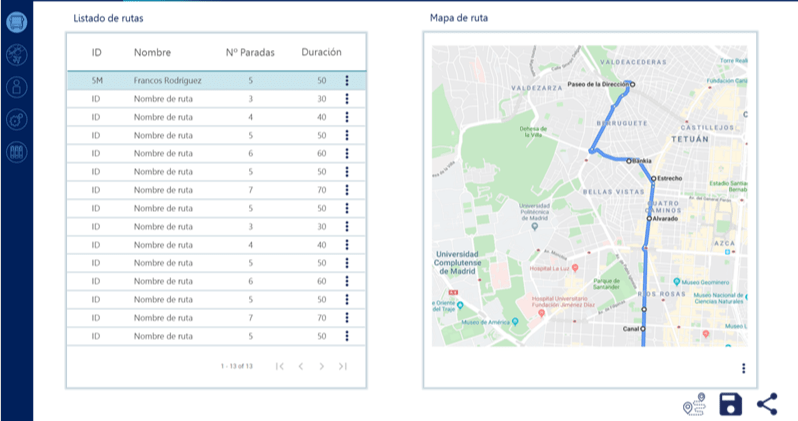
Data monetization
It has been years that Telecom operators have been under great pressure to maintain their profit margins. In addition to the sustained efficiency and cost reduction measures that they have adopted, they are taking on new initiatives to generate new income because as a top executive said “charging more money for the same services is not a viable option”.
Operators sit on vast amounts of customer mobility data collected by their networks that they are using to generate revenue in verticals such as retail, transportation and advertising. They provide highly segmented information on traffic flows that can be used to make decisions about the locations of distribution nodes, traffic dimensioning or the impact of urban advertising.
Operators typically offer aggregated data sets that corporate clients use in decision making. To this end, they have carried out large transformation projects to collect the data from all available sources, clean and integrate it, store it on distributed platforms and make it available to internal and external users. No small feat, as any CDO can attest to.

However, operators are increasingly finding that their customers want answers to questions like: in which of all locations do I need to place my advertising to maximize my ROI? Which are the stores that I need to open with priority? These are typical examples of prescriptive analytics applications, where an algorithm is used to maximize the return on a limited resource.
The mobility data is a great starting point to reach the correct decision, but it neither answers the questions mentioned above nor is it sufficient to guarantee the optimal allocation of resources in terms of ROI, a task that is still under the responsibility of the consumer of the data. Prescriptive analytics bridges the gap between insight and decision.
Prescriptive analytics bridges the gap between insight and decision.
Use cases
1. Point of sale optimization
Crowd analytics offer aggregated data at a level that prevents individual identification, but is sufficiently well segmented to meet the needs of marketing projects. The data show various indicators of flows, mobility and socio-demographic profiles; they distinguish between national and international visitors. This data is of great value, for example, for retail chains because it allows us to know the areas with the highest traffic of the visitor segments of most interest.
However, and as we have mentioned previously, insight is not enough to decide where to open or close stores and ensure that budget or profitability objectives are met. Take the example of a hamburger chain during the lockdown period. Pedestrian traffic has dropped, and sales along with it, while costs remain. Some of the premises need to be temporarily closed. We have the sales and cost figures for each location, which could lead us to choose to keep those with the most positive figures open. We know that reality is not linear, stores close to each other share the demand in their area and if we close one, part of their demand will be transferred to another location. It is necessary to know this transfer of demand to predict the sales of the store that will remain open, with which we return to the starting point and alter the same variable that we are using to make the decision.
Luckily, we have crowd analytics, which reveal the paths that our potential clients follow and gives us an indication of which are the locations that cover the same flows and are more likely to share demand. We can even estimate the demand they share and how closing one will affect the other’s sales. We would be approaching the solution, but of all the possible plans and combinations of stores that I can decide to close, which will be the optimal one considering the transfer of demand and my budget? That is where prescriptive analytics comes into play by using linear programming for example, to define that solution space and find the mathematically optimal solution.
2. Optimization of transit networks
Mobility statistics have an obvious application in the planning of public or private transit networks. Using the information about the origin and final destination of all commuters by public transport, on foot or by private vehicle, at what times, including demographic and socioeconomic information, it is possible to undertake a comprehensive transit plan considering routes, stops, frequencies and prices.
However in real life, resources are limited and the design of such a plan needs to consider their availability in order to maximize benefit. Here again prescriptive analytics can help to find the plan with the maximum benefit (not necessarily in financial terms). Route planning is a classic operations research problem for which there are different resolution methods.

3. Optimization of urban advertising budget
In a similar way to the optimization of points of sale, crowd analytics can offer us the flows of pedestrians discriminating their socioeconomic status and demographics. With this information we can find the locations where our target segment is most likely to pay attention to urban advertising such as billboards.
Again, reality is somewhat more complex. Not only are resources limited, but it is not enough to place advertisements at a certain point. The conversion possibilities depend on how many different hits are received (the so-called “rule of 7” determines that an average of seven interactions with your brand are necessary to achieve a conversion). Maximizing the number of impacts that each billboard receives is not enough, but we have to find the locations that will maximize the number of people within our segment who will receive a sufficient number of hits.
4. Competition analysis + price optimization
Hotels compete among themselves for the attention of their customers. With mobility data, hotels can accurately identify which competitors are visited by their target customers and accurately calculate their traffic share.
In turn, prescriptive analytics can help optimize the impact of marketing campaigns, finding the optimal distribution of the advertising budget, but it can also offer the optimal pricing plan considering the prices of the real competition. A hotel chain can, for each destination, quantify its market share for each segment and origin against real competition, use prescriptive models to adjust its prices to the maximum profit and subsequently, measure the impact of this adjustment on both its market share and its bottom line.
5. Support to emergencies and disasters
A paradigmatic case of the use of crowd analytics is epidemics spread forecast. A good example is Telenor, which with its “Big Data for Social Good” program has taken advantage of the large amount of data that runs through its networks to predict the spread of dengue in Pakistan, malaria in Bangladesh or COVID19 in Norway. Again, prediction is of great help, but it is not enough to determine the ideal allocation of resources, for which prescriptive analytics is an ideal instrument: dynamic allocation of resources can be made based on the expected evolution of the pandemic, taking into account the dynamic effect of the allocation on this evolution.
Another use case is locating emergency calls during natural disasters. In confusing situations such as earthquakes, cyclones or fires, emergency calls provide almost instantaneous information on the most affected locations. With this information, the emergency services decide where to deploy power generators, identify the quickest routes to the affected areas or decide which teams are best able to attend to each one and again, they can use mathematics and prescriptive analytics to maximize the benefit of those decisions.
If you are responsible for data monetization at a mobile operator and you are interested in enriching your Crowd Analytics service offering with prescriptive analytics, our telecommunications business director is at your disposal: Julio Lema julio.lema@baobabsoluciones.es



